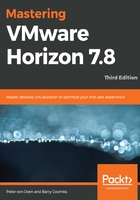
PCoIP offloading with the Teradici PCoIP Hardware Accelerator
In addition to the software solutions discussed in the previous sections, Teradici also offers a server offload card called the Teradici PCoIP Hardware Accelerator. This PCI card is installed in the servers that are hosting the virtual desktop machines.
The first thing to say about this card is that it is not a Graphics Processing Unit (GPU) card. I often hear some confusion around this, and users assume that, by adding an accelerator card, you would get the OpenGL and DirectX capabilities, but this is not the case. You might improve the overall experience and performance, but you won't be adding additional GPU features.
The objective of this card is purely to take the load away from the CPU of the host server when it is processing image encoding operations. Offloading the image encoding to a specialized hardware solution reduces CPU utilization, which, in turn, delivers a consistent end user experience, thereby allowing applications to run more smoothly as they have the resources they require. If you compare it to something such as TCP Offload Engine or the TOE card used in the IP storage world for iSCSI, it's much better to use hardware-based cards than it is to use software initiators.
Freeing up CPU cycles and the overall load on the servers' CPU will potentially result in better consolidation ratios of the virtual desktops, that is, more virtual desktops per host server. Typically, you will see a 1.2 fold increase.
The accelerator card can also be used in conjunction with a GPU. In this scenario, the card efficiently encodes the extra pixels that are generated by the GPU, ensuring the end user has all the benefits that the local GPU can deliver.